
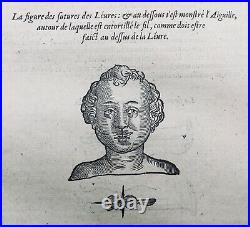
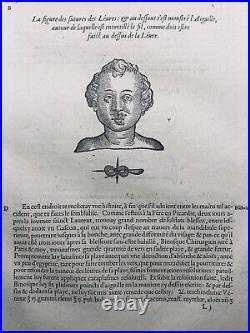
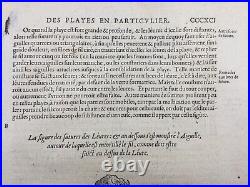
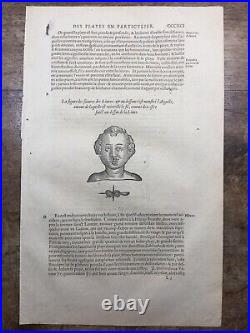
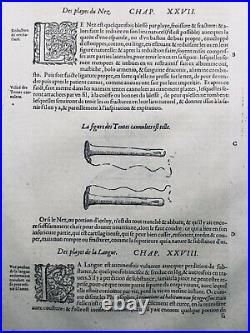
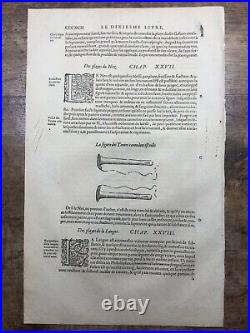

Surgery The Face 1585 Surgery – 1.0fl. OZ Nozzle Set Hare Rare Engraving Medics. The description of this item has been automatically translated. Extremely rare and exceptional woodcuts dating from 1585 on the surgery of the face and the repair of the hare beak of Ambroise Paré, this extraordinary pioneer doctor of reconstructive surgery and prostheses. This page is taken from the book, which describes facial care for the first time in the history of medicine. This page with its two superb woodcuts was published in 1585 in the first edition of the famous work by Ambroise Paré, the king’s surgeon, originally from Laval The works of Ambroise Paré with the figures and portraits of both’anatomy as surgical instruments and several monsters’ This page is taken from the 10th book of the work,’book of wounds in particular. These are undoubtedly the first graphic representations of these medical techniques. Extraordinary historical and scientific document. This document is in the Format of 22/35 cm state see photos, very well preserved for a document which is more than 440 years old. We only sell genuine documents. Do not hesitate to subscribe to our profile in order to receive new announcements in priority. Ambroise Paré, born around 1510 (or 1509 according to sources) in Bourg-Hersent, near Laval (Mayenne), and died on December 20, 1590 in Paris, is a French surgeon and anatomist. Surgeon to the king and the battlefields, Ambroise Paré is often considered the father of modern surgery1. Inventor of many instruments, he participated in the improvement and dissemination of a new kind of cauterization technique. The widespread use of firearms confronts surgeons with wounds of a new kind, which are cauterized with a hot iron or boiling oil at the risk of killing the wounded. Paré perfected the ligation of the arteries2, which he substituted for cauterization, in amputations. “Je le pansay, Dieu le guarist”:this modest sentence of Paré is often quoted to summarize his philosophy quotation in Middle French meaning: I the pansai, God the healer. In 1553, he was a prisoner at the headquarters of Hesdin25 (Old Hesdin26 currently before its destruction by Charles V). At that time, the Confrérie de Saint-Côme, which had brought together barbers and surgeons since the thirteenth century, had recently been transformed into a college of surgery. However, the surgeons remained under the tutelage of the doctors and sought to free themselves from it, or at least to limit it. For example, dissections and autopsies were carried out by surgeons, but, in theory, in the presence of a doctor, the only one authorized to write the report. Paré having a great reputation and the support of the king, the college of Saint-Côme decided to join Paré. This is how he received the master’s cap27 on December 8, 155428, despite opposition from the faculty of medicine and his poor knowledge of Latin, although it was compulsory. The king’s support was strongest29. In 1561 and 1562, he published two other works, including his Universal Anatomy of the Human Body. On January 1, 1562, Catherine de Medici appointed him first surgeon to King Charles IX. Paré was then sent back to the aid of the armies, first to Rouen, then to Dreux and Le Havre. The wars of religion between Catholics and Protestants (Huguenots) have resumed, bloody the country for the next thirty years. From 1564 to 1566, Paré accompanied Charles IX on a visit through France and took the opportunity to uncover new avenues of research. In 1564, he published Ten books on surgery: with the store of the instruments necessary for it, where the first known use of the word scalpel (in fact bistory, feminine) is found in the surgical sense30. The biggest innovation is, for amputations, to ligate the arteries and heal the wound with a mixture of egg yolk, rose oil and turpentine rather than cauterizing with boiling oil. He swears that he will no longer burn the poor wounded so cruelly. I hope you will take better care of kings than the poor? No Sire, it’s impossible. Because I take care of the poor like kings.. In 1561 and 156. Jusqu’au XVIIème siècle. This item is in the category “Books, Comics & Magazines\Antiquarian & Collectable”. The seller is “foulain” and is located in this country: FR. This item can be shipped worldwide.
- Nom: Chirugie Esthetique
- Binding: Non-connected, article
- Language: French
- Name of publication: Chirugie Esthetique
- date of publication: 1585
- period: Until XVIIth siècle
- Author: Ambroise Paré
- Place of Publication: FRANCE
- Object modified: Non
- Special Attributes: Edition original
- topic: History
- Brand: Unbranded
